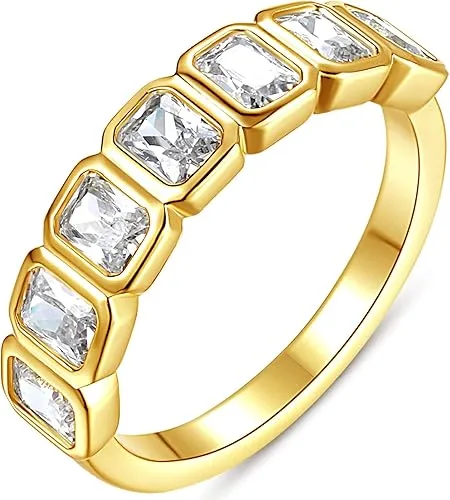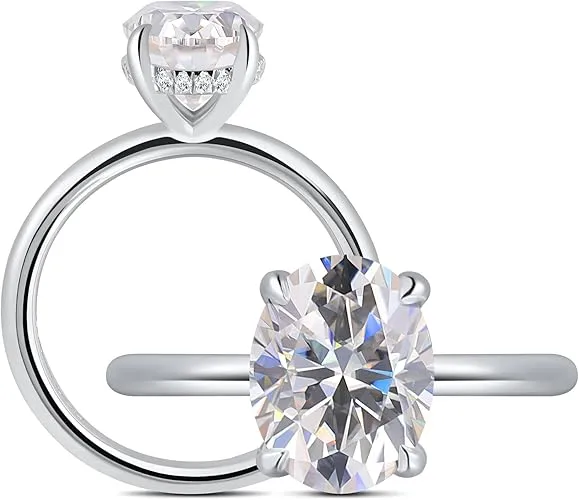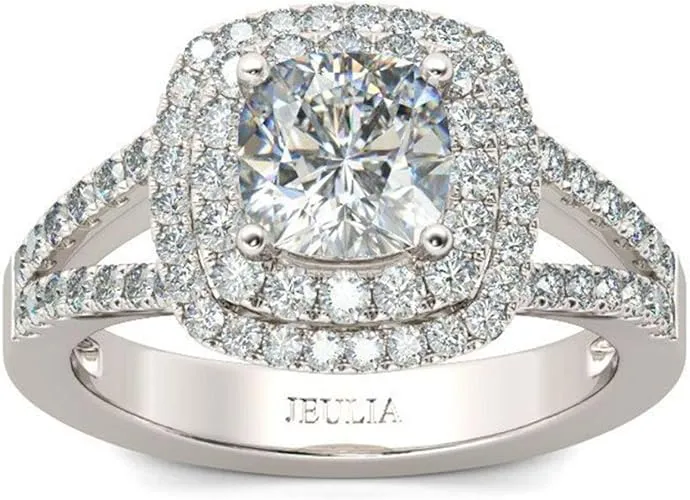When it comes to choosing the perfect engagement ring, the setting plays a crucial role. The setting not only secures the diamond or gemstone but also enhances its beauty and defines the overall design of the ring. Whether you’re drawn to classic styles or modern aesthetics, understanding the different engagement ring settings can help you find the ideal match for your style and preferences. With a variety of options available, we’ll cover 14 of the most popular and significant settings to help you explore the choices that truly stand out
What is an Engagement Ring Setting?
The setting of an engagement ring is more than just a way to hold the gemstone in place—it’s the foundation of the ring’s style, durability, and sparkle. Each setting type offers a unique way to display the stone, influencing not only how much light it reflects but also how secure and practical the ring will be for everyday wear. From timeless prongs to sleek bezels, the right setting balances beauty and functionality, making it essential to consider both aesthetics and lifestyle when choosing a setting that best fits your vision.
Engagement Ring Settings
1. Prong Setting (Solitaire)
Description: The prong setting is classic and widely popular for its ability to maximize light exposure to the stone. Metal prongs (typically four or six) grip the gemstone securely while elevating it above the band.
- Ideal for: Round, oval, and princess-cut diamonds, as this setting allows their sparkle to shine.
- Pros:
- Enhances light reflection for maximum brilliance.
- Allows the diamond or gemstone to stand out.
- Versatile and timeless look.
- Cons:
- Prongs can catch on clothing or hair.
- May require regular maintenance to ensure prongs stay secure.
- Tip: Opt for a prong setting if you love simplicity and a diamond-forward design, but have it inspected periodically to prevent prong wear.

2. Bezel Setting
Description: The bezel setting surrounds the stone with a metal rim, protecting its edges. Unlike prongs, the bezel secures the entire circumference of the gemstone.
- Ideal for: People with active lifestyles or those seeking a sleek, modern design.
- Pros:
- Extra protection for the stone, reducing the risk of chipping.
- Great for vintage-inspired rings and smaller stones.
- Minimal maintenance as no prongs are involved.
- Cons:
- Less light exposure, which can slightly reduce sparkle.
- Can obscure part of the stone’s shape.
- Tip: Bezel settings work well with round or oval cuts, making the ring durable and suitable for daily wear.

3. Halo Setting
Description:The halo setting features a ring of smaller diamonds or gemstones that encircle the central stone. This setting creates the illusion of a larger center stone, making it a popular choice for those who want added sparkle.
- Ideal for: Those looking for maximum sparkle and a larger-looking center stone.
- Pros:
- Adds dramatic sparkle and increases perceived stone size.
- Complements round, oval, and cushion cuts beautifully.
- Cons:
- More costly due to additional stones.
- Small stones in the halo may require occasional replacement.
- Tip: Halo settings add glamor and suit those wanting a vintage-inspired or eye-catching design.

4. Cathedral Setting
Description:The cathedral setting is a vintage-inspired design where the band arches upward, creating a cathedral-like structure that elevates the central gemstone. This setting allows for a great view of the stone and enhances its appearance.
- Ideal for: Elegant and timeless styles with a hint of vintage appeal.
- Pros:
- Enhances stone visibility and brilliance.
- Adds height, making the ring appear larger and more impressive.
- Cons:
- Higher profile can snag on clothing.
- Slightly more vulnerable to impacts.
- Tip: If you love height and elegance, the cathedral setting enhances ring presence and pairs beautifully with many wedding bands.

5. Tension Setting
Description:In a tension setting, the gemstone is held in place by the pressure of the band itself. The metal band is shaped to create tension, which secures the stone without any prongs or bezels. This modern and unique setting showcases the stone in a dramatic way.
- Ideal for: A contemporary, minimalist look.
- Pros:
- Provides a futuristic and minimalist look.
- Allows maximum light to shine through the gemstone.
- The stone appears to “float” above the band, creating an elegant effect.
- Cons:
- Requires precise cuts; may not fit all gemstones.
- Can be challenging to resize due to band tension.
- Tip: Tension settings are bold, but ensure the stone is cut to perfection to avoid slipping.

6. Pavé Setting
Description:The pavé setting features small diamonds or gemstones that are set closely together, covering the band or surrounding the center stone. The name “pavé” comes from the French word for “paved,” as the design resembles a paved road of stones.
- Ideal for: Adding sparkle to a solitaire ring or creating a shimmering effect along the band.
- Pros:
- Adds a lot of sparkle and brilliance to the ring.
- Great for those who want a lot of diamonds without the high cost of large stones.
- Can be used to complement the center stone.
- Cons:
- The small diamonds may require more maintenance, as they can become loose over time.
- More difficult to resize due to the tight settings.
- Tip: Pavé settings create dazzling sparkle, ideal for those seeking glamor. Regular check-ups help keep small stones in place.

7. Three-Stone Setting
Description:The three-stone setting, also known as a trilogy setting, features three stones, often representing the past, present, and future of the couple’s relationship. The stones can be diamonds or gemstones, and the setting may be done in a prong, bezel, or other styles.
- Ideal for: A meaningful design with room for personalization.
- Pros:
- Unique, sentimental look.
- Complements multiple gemstone shapes and colors.
- Cons:
- May be more expensive due to the extra stones.
- Requires careful selection of the center stone and side stones for a balanced appearance.
- Tip: This setting works well with gemstones that carry personal meaning, making it both symbolic and beautiful.

8. Channel Setting
Description:The channel setting involves setting gemstones into a groove along the band, creating a seamless row of stones. This setting is typically used for smaller diamonds or gemstones, especially along the band.
- Ideal for: Active lifestyles, as stones are protected within the band.
- Pros:
- Offers a smooth, flush appearance without prongs.
- Less likely to snag on clothing.
- Durable design, well-suited to daily wear.
- Cons:
- The stones can be difficult to clean due to their setting.
- It can be hard to resize the band due to the tight settings.
- Tip: Choose a channel setting for a clean, contemporary look with extra protection for smaller stones.

9. Flush Setting
Description:In a flush setting, the gemstone is set directly into the metal band, with the top of the stone flush with the surface of the band. This low-profile setting provides a sleek and modern look.
- Ideal for: Those looking for a low-profile, modern design.
- Pros:
- Very secure and durable.
- Minimalistic, clean look.
- Cons:
- Reduced sparkle due to limited light.
- Can be difficult to clean, as dirt can accumulate around the stone.
- Tip: This is perfect for people who work with their hands or prefer understated jewelry.

10. Bar Setting
Description: In a bar setting, two vertical metal bars hold the gemstone in place on two sides, often on the left and right. This design is commonly used for engagement rings as well as for side stones in wedding bands, as it allows light to pass through the top and bottom of the stone.
- Ideal for: Couples seeking a contemporary, minimal look that allows plenty of light to enter the gemstone.
- Pros:
- Sleek, modern aesthetic.
- Good light exposure, enhancing gemstone sparkle.
- Cons:
- Gemstone edges are more exposed, making it slightly more vulnerable to damage.
- Resizing can be more complex due to the structure.
- Tip: This setting works well with larger gemstones or diamonds, creating a clean-lined, open look that allows light to pass through beautifully.
11. Basket Setting
Description: The basket setting features prongs that secure the gemstone but are shaped like a basket, with additional crossbars or wires underneath. This gives the ring a vintage-inspired yet modern look, holding the gemstone higher off the band and allowing more light to reach the stone.
- Ideal for: Those looking for a secure, raised setting with a touch of sophistication.
- Pros:
- Provides excellent visibility and maximizes light exposure.
- Offers strong support for the gemstone, making it very secure.
- Cons:
- Basket design can occasionally catch on clothing or hair.
- The high setting can make the ring more prone to damage.
- Tip: The basket setting is ideal for round and cushion-cut stones, as it accentuates their sparkle and brilliance while providing a unique look.

12. East-West Setting
Description: In an east-west setting, the gemstone is oriented horizontally across the band rather than the traditional vertical alignment. It’s a striking, modern design often used with elongated stones like ovals, emeralds, or marquise cuts, creating a fresh and unconventional look.
- Ideal for: People who appreciate non-traditional styles and are drawn to unique engagement ring designs.
- Pros:
- Eye-catching, modern, and artistic.
- Works beautifully with elongated stones, showcasing them in a new way.
- Cons:
- May not suit those who prefer classic, traditional designs.
- The horizontal setting may leave edges more exposed, increasing vulnerability.
- Tip: Choose an east-west setting if you love an unconventional, contemporary ring design. It’s perfect for oval or marquise gemstones, which look striking in this orientation.

13. Split Shank Setting
Description: The split shank setting features a band that divides into two or more separate strands as it approaches the center stone, creating a visually appealing and intricate look. This setting is highly customizable, with designs that can range from simple to elaborate.
- Ideal for: Elegant and luxurious designs, especially if you want the center stone to appear larger and more prominent.
- Pros:
- Adds drama and sophistication to the ring’s design.
- Enhances the appearance of the center stone, making it appear larger.
- Cons:
- The split design may feel delicate or fragile, especially with finer bands.
- Often more expensive due to the intricate design and additional metalwork.
- Tip: A split shank setting is ideal if you want a luxurious, eye-catching ring. It works exceptionally well with round and cushion-cut gemstones, making them appear more prominent.

14. Twist Setting
Description: The twist setting involves twisting the metal band around the gemstone, creating a spiral or helix-like effect. This setting is often chosen for its dynamic, flowing look, making it popular with individuals who want an artistic, modern ring.
- Ideal for: People who love artistic designs and prefer something more unique than traditional settings.
- Pros:
- Creates a beautiful, flowing, and dynamic design.
- Perfect for those wanting a unique and non-traditional look.
- Cons:
- The twist design can feel more delicate, depending on the thickness of the twist.
- The gemstone’s positioning may leave it more exposed to wear and tear.
- Tip: The twist setting works well with round and oval stones, accentuating their curves and creating a striking visual effect that’s both romantic and modern.

| Setting | Style | Protection | Sparkle | Maintenance | Best For |
|---|---|---|---|---|---|
| Prong (Solitaire) | Classic | Moderate | High | Prongs checked often | Traditional, classic look |
| Bezel | Modern | High | Moderate | Minimal upkeep | Active wear, vintage-inspired designs |
| Channel | Elegant | High | Low | Minimal upkeep | Low-profile, modern aesthetics |
| Pavé | Dazzling | Low | High | Occasional cleaning | Glamorous, luxurious design |
| Tension | Contemporary | Moderate | High | Professional cleaning needed | Modern statement rings |
| Halo | Vintage-inspired | Moderate | Very High | Regular cleaning needed | Extra sparkle, vintage look |
| Twist | Artistic | Low to Moderate | High | Occasional upkeep | Flowing, dynamic appearance |
| Flush | Minimalist | Very High | Low | Minimal | Active wear, subtle designs |
| Cathedral | Elegant | Moderate | High | Regular polishing | Vintage-inspired, adding height |
| Bar | Sleek | Moderate | High | Occasional maintenance | Modern bands |
| Basket | Classic | Moderate | High | Professional cleaning | Secure, elevated setting |
| East-West | Artistic | Moderate | High | Prongs checked regularly | Unconventional look |
| Split Shank | Intricate | Moderate | High | Varies | Bold, eye-catching design |
| Three-Stone | Sentimental | Moderate | High | Occasional cleaning | Symbolic settings |
Choosing the Right Setting for You
Selecting the perfect engagement ring setting goes beyond aesthetics; it’s about balancing style with practicality. Here are key factors to consider:
Consider Your Lifestyle: Active individuals should opt for protective settings like bezel or tension, which secure the stone and prevent damage. Delicate settings, such as prong or pavé, enhance sparkle but are more exposed and less protective.
Choose a Setting That Compliments the Gemstone: Match the gemstone’s shape with the setting. Halo settings make smaller stones appear larger, while solitaire settings showcase a single large gem. Oval or emerald cuts look great in east-west settings.
Think About the Band: Band styles vary from vintage (cathedral) to modern (solitaire). Consider whether you prefer intricate details (pavé) or a minimalist look.
Budget: Simpler settings like solitaire tend to be more affordable, while intricate designs such as pavé or halo may increase the cost due to extra stones and craftsmanship.
Maintenance: Some settings, like pavé, require frequent cleaning. Bezel and tension settings are easier to maintain as they protect the stone.
Personal Taste & Symbolism: Choose a setting that reflects your style, whether traditional, modern, or unique. The setting can also symbolize the significance of your relationship.
Resizing: More intricate settings can be difficult to resize, so consider future adjustments when selecting your design.



